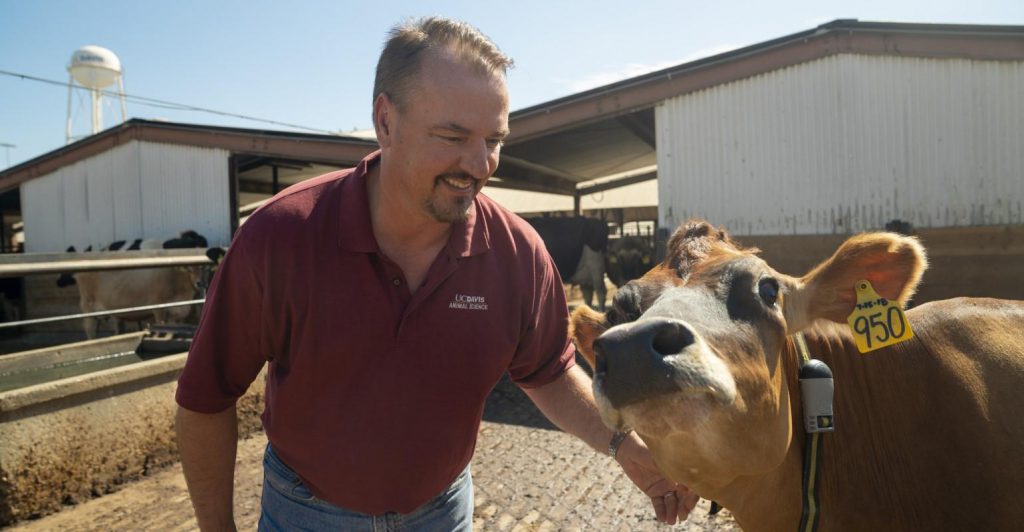
Researchers from the University of California-Davis (UC-Davis) are rethinking methane and showing that climate neutrality is within reach for the California dairy sector.
Methane is a potent greenhouse gas that is 25-28 times stronger than carbon dioxide — the primary greenhouse gas driving climate change in California — but how it influences actual warming is much different, according to a white paper released by UC-Davis professors Dr. Frank Mitloehner and Dr. Ermias Kebreab, along with Michael Boccadoro, executive director of Dairy Cares. The paper, “Methane, Cows & Climate Change: California’s Dairy’s Pathway to Climate Neutrality,” examines recent literature from leading climate scientists and its implications for the California dairy sector.
Methane is a climate pollutant that exists in the atmosphere for 12 years before it is broken down. This means, when a constant rate of methane is emitted for more than 12 years, one molecule, in effect, replaces a previously emitted molecule that has since been removed. In other words, methane isn’t accumulating in the atmosphere. Currently, the main accounting method used for measuring the climate impacts of greenhouse gases does not describe how individual gases such as methane warm — or cool — the climate over time. That oversight leads to a misinterpretation of methane’s role in warming the climate, while also ignoring possible solutions that could offset greenhouse gases from other sectors such as transportation.
“We have been looking at methane incorrectly when it comes to reducing warming,” said Mitloehner, a professor and air quality specialist for Cooperative Extension in the UC-Davis department of animal science and head of the Clarity & Leadership for Environmental Awareness & Research (CLEAR) Center. “While more potent than the most prevalent greenhouse gas carbon dioxide, methane is a short-lived climate pollutant, staying in our atmosphere for about 12 years before it’s broken down and removed. On the other hand, carbon dioxide remains in our atmosphere for centuries, with new emissions accumulating on top of those previously emitted, making it the main driver of climate change.”
According to the white paper, which examined historic dairy production in that state, California dairy farms have already stabilized methane emissions, which is a critical step to achieving climate neutrality and global climate goals. The authors explain, that as dairies continue to achieve further methane emission reductions, then they can create negative warming, also referred to as “cooling.”
California is the fifth-largest economy in the world and is responsible for about 1% of all global greenhouse gas emissions. More than 80% of California’s greenhouse gas emissions come from fossil fuel uses, such as in the transportation (41%), industrial (23%) and power-generating (16%) sectors. Even though California is the largest agricultural producer in the U.S. — producing fruits, vegetables, nuts, livestock and other essential foods for much of the nation and the world — the agriculture sector’s greenhouse gas contribution is roughly 8% of the state’s total greenhouse gas emissions. Of this, California’s largest-in-the-nation dairy sector accounts for 4% of the state’s total greenhouse gas emissions.
To its credit, the state has established goals for reducing greenhouse gas emissions 40% by 2030 and 80% by 2050 as it works toward a goal of “net-zero” carbon emissions by 2045.
Given greater efficiencies, plus a decrease in the number of cows and total milk production in recent years, the amount of methane emitted by California dairies is less today than in 2008. Simply put, California dairy farms are adding less methane today than they did 12 years ago, meaning more methane is being broken down than is being emitted into the atmosphere.
California’s dairy farmers are making further progress in reducing the amount of methane emissions released into the environment by installing anaerobic digesters designed to capture methane or through other projects like compost pack barns and solid separators, which are designed to reduce methane production on farms. According to the California Department of Food & Agriculture, California dairies are implementing projects that will result in a 25% reduction in manure-related methane emissions versus 2013.
Continued progress in these areas will be necessary for the state’s dairy production sector to reach the point at which it is no longer adding to global warming, which is known as climate neutrality.
“Reducing methane emissions and achieving climate neutrality is no small undertaking,” said Kebreab, who holds the Sesnon Endowed Chair in Sustainable Animal Agriculture in the UC-Davis department of animal science. “California is among the most efficient producers of milk and dairy products, and its life-cycle carbon footprint (per gallon of milk produced) is among the lowest of any region in the world. Further reductions will be accelerated as dairy methane reduction projects are implemented and feed additives become widely available. For other dairy regions, a critical first step will be to achieve similar levels of production efficiency (more milk with fewer cows) to begin stabilizing methane emissions and work toward climate neutrality. The impact of such an accomplishment would have profound global climate effects.”
The white paper identifies methane as an important mitigation opportunity. It also follows research on notable differences among individual greenhouse gases and their impact on climate change by leading scientists at the Oxford Martin School and Environmental Change Institute at the University of Oxford.



Pingback: Sunday Reading – 09/20/2020 | Romick in Oakley